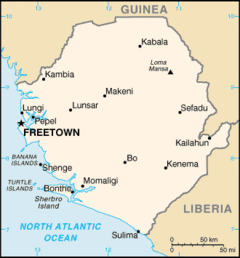Freetown
2007 Schools Wikipedia Selection. Related subjects: African Geography
Freetown, population 1,070,200 ( 2004), is the largest city and capital of Sierra Leone, lyingon the Freetown Peninsula on the Atlantic coast. The city is a port on the Atlantic Ocean. Freetown's economy revolves largely around its harbour, which handles the country's main exports. Industries include fish packing, rice milling, petroleum refining, and the manufacture of cigarettes.
History
The area was first settled in 1787 by freed slaves sent from England and Canada as well as Jamaican Maroons and Black American Loyalists. It is said to have previously been a slave market, by British abolitionists, who started the Sierra Leone Company. It was burnt by the local population under King Jimmy in 1790.
Slaves who had fled the newly-independent USA to England were resettled here by the British Government. In 1792, Freetown was founded by former slaves from Nova Scotia, and survived being pillaged by the French in 1794. The indigenous inhabitants revolted in 1800, but the British retook control, beginning expansionism which led to the creation of Sierra Leone. From 1808 to 1874 the city served as the capital of British West Africa. The city expanded rapidly as many freed slaves settled, accompanied by African soldiers who had fought for Britain in the Napoleonic Wars. During World War II, Britain maintained a naval base at Freetown. Descendants of the freed slaves, called Creoles, play a leading role in the city, even though they are a minority of the population.
The city was the scene of fierce fighting in the late 1990s. It was captured by ECOWAS troops seeking to restore President Ahmad Tejan Kabbah in 1998, and later it was unsuccessfully attacked by rebels of the Revolutionary United Front.
NB: The story of the settlement of Freetown is told in Simon Schama's book " Rough Crossings, Britain, Slaves and the American revolution", ISBN 0-563-49365-8.
Travel
Airports
Lungi International Airport is the international airport of Sierra Leone. Freetown a heliport on Aberdeen Island, connecting the city with the airport. There is a frequent helicopter, hovercraft and ferry-service to Lungi.
Features
One of Freetown’s most recognisable features is its famous cotton tree. The cotton tree has reportedly been in the same position since colonists settled in the area in 1787 when the tree was still a young sapling. It now stands outside the Freetown Museum.
Notable buildings in the city include Freetown Law Courts, the Slave Gate and Portuguese Steps, St John's Maroon Church (built around 1820), St George's Cathedral (completed in 1828), Foulah Town Mosque (built in the 1830s) and the Roman Catholic Sacred Heart Cathedral. Also in Freetown are assorted beaches and markets, and the Sierra Leone Museum featuring the Ruiter Stone, nomoli and masks.
Freetown's suburbs stretch along the coast, from the East End Wellington, Kissy, Cline Town, Fourah Bay, Kossa Town and Foulah Town and a West End of Congo Town, Murray Town, Wilberforce and Aberdeen.
The city is the site of the permanent home of Fourah Bay College and the temporary home of Njala University college (which formed part of the University of Sierra Leone).
It is twinned with:
- Kingston upon Hull in northern England and
- New Haven, Connecticut, USA.

